If you have an orchid with yellow leaves, it is logical and understandable that you are alarmed and think you might lose your orchid. Learn all about orchid leaves turning yellow in this article.
I’ll tell you something, if you don’t act quickly you can lose your orchid, but if you detect what the problem is and solve it in time, it will not stop being a little scary.
There are four reasons why orchid leaves turning yellow, three of them are very easy to fix, and the worst is the last one:
There is also a fifth option, that the leaves have finished their life cycle. In these cases, it is normal that they turn yellow, wither, and die.
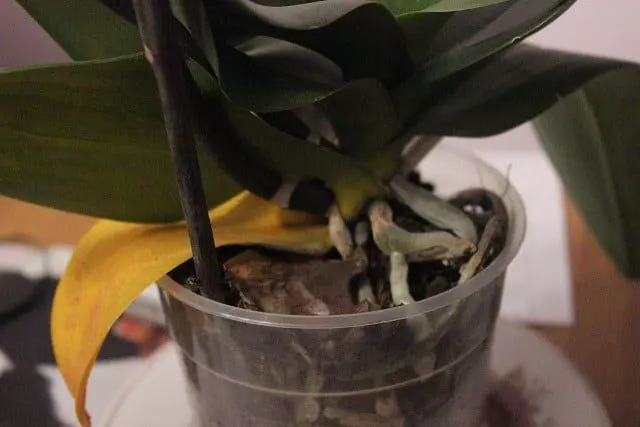
Table of Contents
Why are my Orchid Leaves Turning Yellow?
Why are my Orchid Leaves Turning Yellow? This process takes place naturally when the leaves of your orchids have finished their life cycle. The plant thus renews the leaves at the bottom of the stem and prepares for a new flowering. In that case, let them fall off by themselves or cut them off with clean scissors.
However, if the upper leaves of the orchid turn yellow and your orchid loses its leaves, it may be a symptom that there is something to improve in its care.
Orchid Leaves Turning Yellow from Watering
One of the most common causes of orchid leaves yellowing is improper watering…either due to lack of watering or overwatering.
Most commonly they will turn yellow when watering is excessive, but depending on the variety and condition of the orchid, it can also be due to lack of watering.
Insufficient Watering
In Phalaenopsis orchids, it can happen that even with correct watering and normal-looking leaves, some leaves start to turn yellow.
If it is not a new leaf, which will have a light green coloration, or a very old leaf, which may be losing its color due to age, sometimes the watering is not enough and some or all of the leaves start to yellow.
Insufficient watering in orchids is easy to solve. In these cases, it is best to use immersion watering, then let the orchid release the excess water. The problem will be solved in a few days.
Excess Water
Over-watering is the most common “and likely” cause of orchid leaves yellowing.
The most common orchids, the Phalaenopsis, do not require frequent watering, watering should be spaced and above all, control the needs of the plant through the roots.
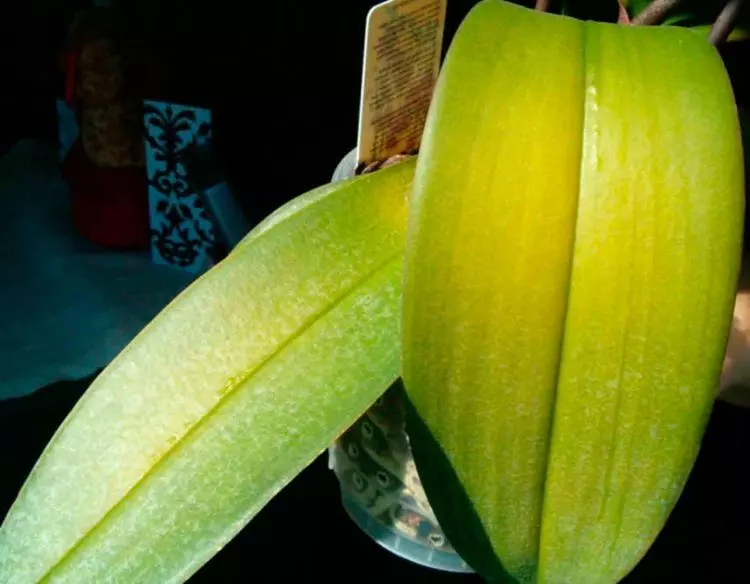
I recommend you take into account the variety of your orchid, to determine its watering needs.
As a generic rule, the orchid with yellow leaves is affected by over-watering when:
1- Most of the leaves are yellow, not just the lower leaves.
2- Black spots appear on the leaves.
3- The leaves have become softer to the touch than normal, are soft, and have lost vitality.
4- We can observe how the roots have a darker tone than usual; we can even detect dark spots.
5- It may be that the excess water is causing rot in the roots, in this case, it is convenient to change the pot eliminating the affected roots.
Another reason why the leaves of the orchids can be turning yellow, and why the water of the irrigation takes importance, is in the number of salts dissolved in the water (hard water, excess calcium, and other salts).
These salts end up staying in the orchid’s substrate and can cause the leaves to turn yellow. In this case, the solution will be to change the soil or regulating the pH of the soil. Learn more about how to measure soil pH.
Orchid Leaves Turning Yellow Caused due to Poor Lighting and Temperature
Orchids need (mostly) good lighting, but they hate the direct sun.
When the illumination is excessive, many varieties of orchids show this through their leaves, which take on a lighter green or turn yellow, and their flowers can take on a darker color.
Sometimes, when the exposure to the sun has been direct, we will appreciate burns on the leaves, easily detectable because the affected area withers.
In order not to make that leaf so ugly, you can cut the affected part of the leaf. Remember that for many orchids their leaves are water and nutrient storage organs, so it is not advisable to remove the leaves completely if it is not necessary.
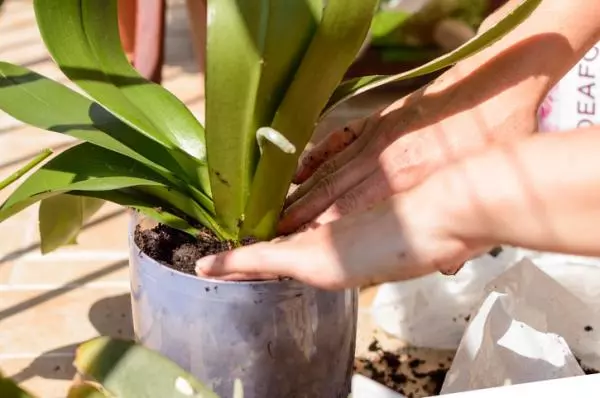
Orchid Leaves Turning Yellow due to Excess Fertilizer
Orchid Leaves Turning Yellow due to Excess Fertilizer. Fertilization errors in orchids can also cause yellowing of the leaves and their falling off.
You have to be very careful with orchid fertilizers, since they have to be specific and used in the proportions marked by the manufacturers.
An excess of fertilization will cause the opposite effect to the one we want to achieve, the orchid will start to weaken, and its leaves will turn yellow.
The golden rules for using fertilizers in orchids are:
1- Usually, orchids are fertilized during their growth period.
2- Orchids should always be fertilized after watering or in combination with the water from the irrigation. Never fertilize with a dry substrate.
3- Depending on the variety of orchid, when winter arrives, fertilization should be reduced or eliminated.
4- If you have a weak or sick orchid, do not fertilize it.
5- Do not fertilize during the first days after a transplant.
A lack of nutrients and fertilizer could cause orchid leaves turning yellow, although an excess of fertilizer is always more dangerous.
In these cases, the orchid will yellow due to a lack of potassium, usually because the substrate is already old. This circumstance is easy to solve by transplanting the orchid into a new substrate.
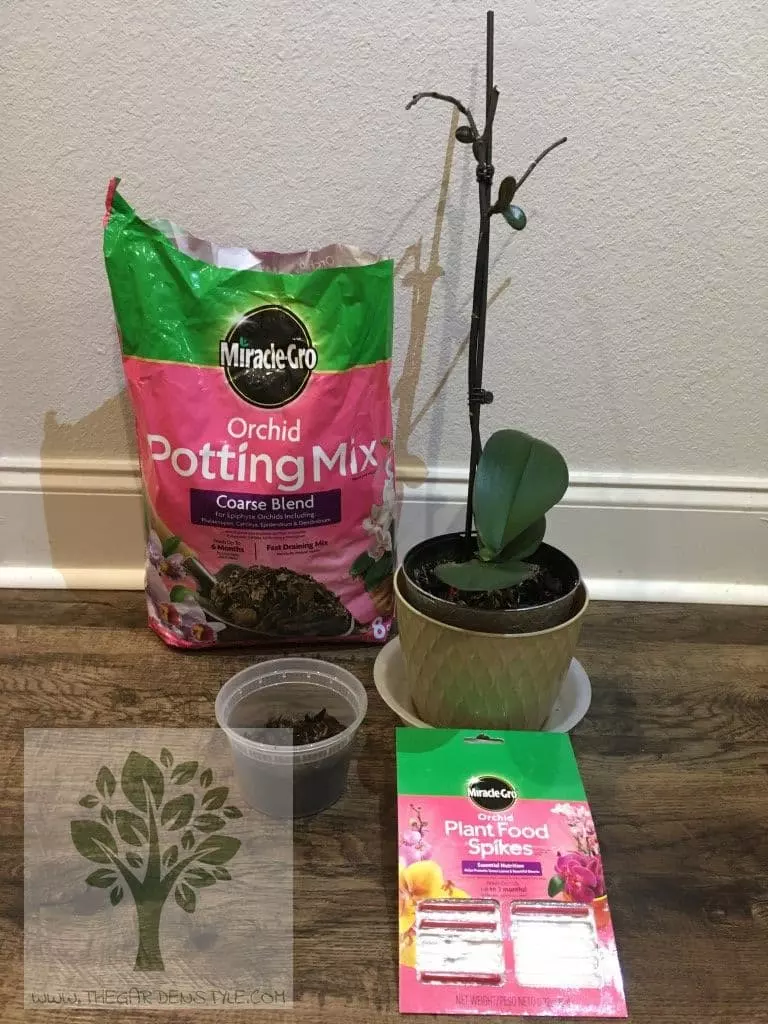
To keep our orchids healthy and strong at home, we use the following products.
- Miracle-Gro 8 Qt. 4 Lb. Coarse Blend Orchid Potting Soil (2 pack)
- Specially formulated for Epiphyte orchids including: Phalaenopsis, Cattleya, Epidenfrum, and Dendrobium
- Feeds plants for up to 6 months
Orchid Leaves Turning Yellow Caused by Disease
The diseases that usually cause orchids with yellow leaves are related to infections caused by fungi or viruses.
When we observe an orchid with yellow leaves, we must separate it from the rest, until we discover the problem, to prevent the disease from spreading.
Fungi
When the attacks are produced by fungi, we will see leaves with yellow dots and a black center.
Many Asian orchids suffer from fungal attacks, without it being a serious problem for the orchid.
The main reason for the fungus attacks is poor ventilation, too high humidity, and poor lighting.
To avoid the appearance of fungi, we will avoid watering the leaves, improve the ventilation of the place where the orchids are kept, and improve the lighting.
It is advisable to supplement with a systemic fungicide, to reduce the problem completely.
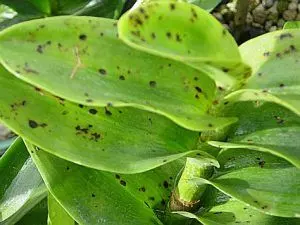
Virus
If the attack is caused by a virus, the solution is simple “if it is solved”, although the virus attack is irreversible.
In these cases, the only thing we can do is improve the situation of the orchid, as I mentioned a couple of lines above, and hope that the virus will remit.
After a while, if it does not remit, it is better to get rid of the specimen… which of course must remain isolated from the rest.
Orchids that have been attacked by viruses no longer bloom in the same way.
Orchid Leaves Turning Yellow by Natural Cycle
There is also another reason why your orchids start to have yellow leaves and, in fact, it is one of the most common causes. The age of the plants can affect them, so if you have several years with your orchids, it is most likely that the leaves turn yellow because of their life cycle. In this case, the only thing you should do is to let them wither and fall off by themselves.
If you are a fan of orchids, we recommend our other articles about orchids:
Best Soil for Orchids – Healthy Orchids
Best Pots for Orchids – Ultimate Guide


